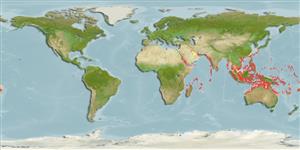>
Scombriformes (Mackerels) >
Scombridae (Mackerels, tunas, bonitos) > Scombrinae
Etymology: Grammatorcynus: Greek, gramma = signal, mark + Greek, rhyngchos = snout.
More on author: Rüppell.
Environment: milieu / climate zone / depth range / distribution range
Ecologia
marinhas associadas(os) a recifes; oceanódromo (Ref. 51243); intervalo de profundidade 15 - 50 m (Ref. 86942). Subtropical; 31°N - 25°S, 32°E - 175°W (Ref. 168)
Indian Ocean: Red Sea eastward to the Andaman Sea. Western Pacific: Ryukyu Islands to the northern coasts of Australia, including the Marshall Islands and Fiji. Often confused in the literature with Grammatorcynus bicarinatus.
Length at first maturity / Tamanho / Peso / Idade
Maturity: Lm 41.5, range 40 - 43 cm
Max length : 100.0 cm FL macho/indeterminado; (Ref. 9684); common length : 50.0 cm TL macho/indeterminado; (Ref. 5450); peso máx. Publicado: 3.5 kg (Ref. 168)
Espinhos dorsais (total) : 11 - 13; Raios dorsais moles (total) : 10 - 14; Espinhos anais: 0; Raios anais moles: 10 - 14. Mouth relatively small, upper jaw reaching about to middle of eye. Pectoral fins stout. Interpelvic process short and single. No prominent anterior corselet present. Swim bladder present. Vertebrae 14 precaudal plus 17 caudal, total 31 as in mackerel (Scomber and Rastrelliger).
Inhabits open water but often seen swimming near outer reef walls or deep clear-water slopes (Ref. 48637). Found mostly in shallow reef waters where it forms large schools. Feeds on crustaceans and fishes, particularly clupeoids (Sardinella, Thrissocles), and other fishes such as Sphyraena and Balistes. Marketed canned and frozen (Ref. 9684). Its flesh is mild and pleasantly flavored, but brushed with lemon juice prior to cooking to remove the ammonia-like smell (Ref. 9684).
Collette, B.B. and C.E. Nauen, 1983. FAO Species Catalogue. Vol. 2. Scombrids of the world. An annotated and illustrated catalogue of tunas, mackerels, bonitos and related species known to date. Rome: FAO. FAO Fish. Synop. 125(2):137 p. (Ref. 168)
Categoria na Lista Vermelha da IUCN (Ref. 130435: Version 2024-1)
Ameaça para o homem
Harmless
Utilização humana
Pescarias: pouco comercial; peixe desportivo: sim
Ferramentas
Relatórios especiais
Descarregue XML
Fontes da internet
Estimates based on models
Preferred temperature (Ref.
123201): 25.6 - 29.1, mean 28.2 °C (based on 632 cells).
Phylogenetic diversity index (Ref.
82804): PD
50 = 0.7500 [Uniqueness, from 0.5 = low to 2.0 = high].
Bayesian length-weight: a=0.00955 (0.00460 - 0.01984), b=3.06 (2.89 - 3.23), in cm total length, based on LWR estimates for this (Sub)family-body shape (Ref.
93245).
Nível Trófico (Ref.
69278): 4.2 ±0.69 se; based on food items.
Resiliência (Ref.
120179): Médio, tempo mínimo de duplicação da população 1,4 - 4,4 anos (Preliminary K or Fecundity.).
Fishing Vulnerability (Ref.
59153): High to very high vulnerability (67 of 100).
Climate Vulnerability (Ref.
125649): Very high vulnerability (89 of 100).
Nutrients (Ref.
124155): Calcium = 15 [8, 33] mg/100g; Iron = 0.698 [0.368, 1.368] mg/100g; Protein = 22.3 [20.9, 23.7] %; Omega3 = 0.204 [0.117, 0.367] g/100g; Selenium = 18.2 [9.1, 38.1] μg/100g; VitaminA = 47.6 [16.1, 154.0] μg/100g; Zinc = 0.491 [0.327, 0.753] mg/100g (wet weight);
